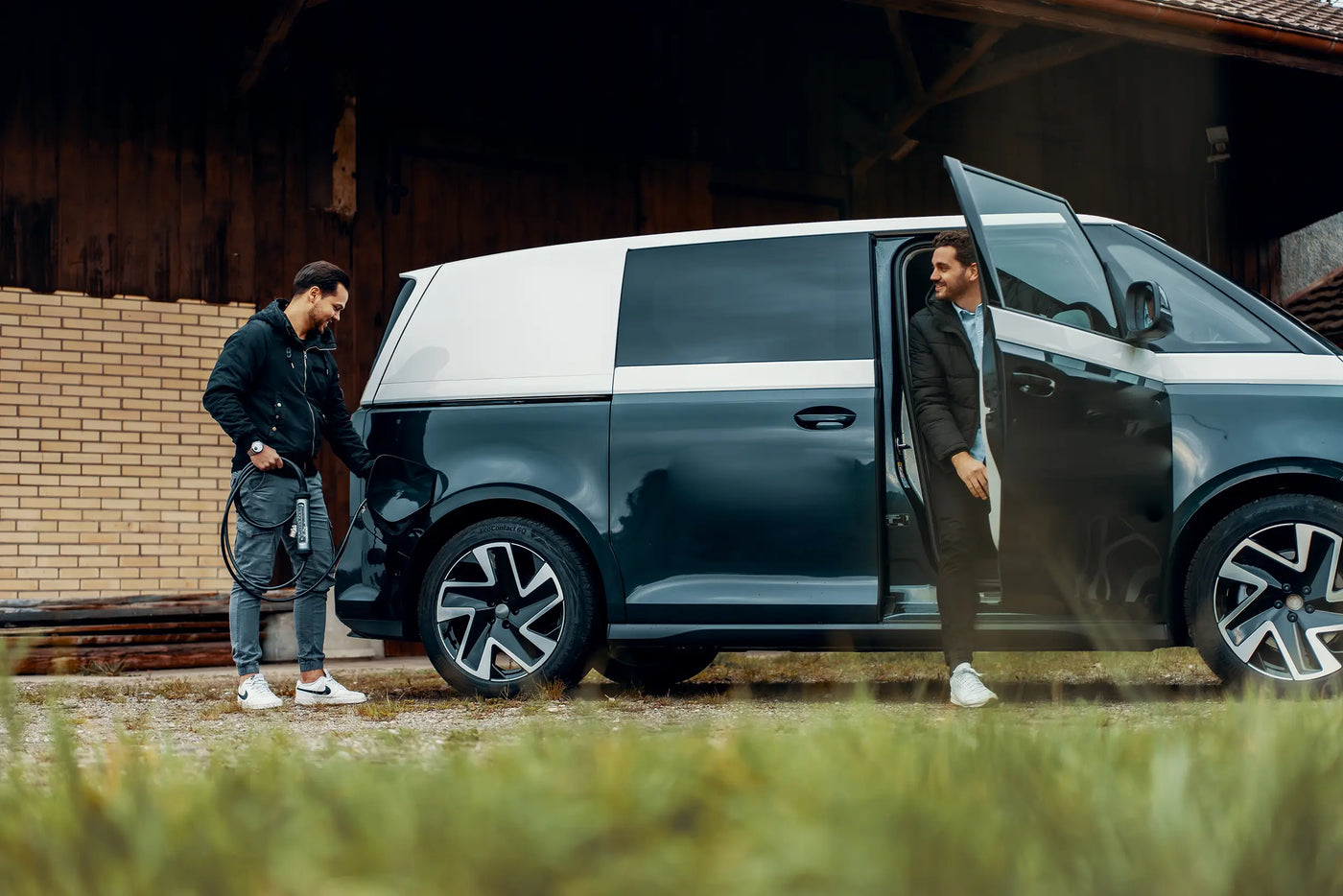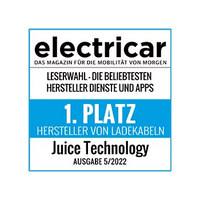Myths and facts: Eight arguments for e-mobility that will convince even the most stubborn petrolheads at the pub
Too little power, batteries don't last long, charging takes forever – prejudices against electric vehicles persist. Time to dispel the myths! Here are some hard facts that show that the future is electric.
- “There isn’t enough electricity for everyone – so should we drive combustion engines instead?”
- “Batteries only last three years and then have to be replaced!”
- “Lithium extraction consumes vast amounts of water and is therefore problematic!”
- “Loading takes forever!”
- “There isn’t enough electricity in apartment buildings!”
- “Landlords and owners are resisting charging infrastructure!”
- “There are too few charging stations!”
- “Electric cars run on coal-fired power and are not sustainable”
Conclusion: Electromobility demystifies myths
1. “There isn’t enough electricity for everyone – so should we drive combustion engines instead?”
Not at all! The assumption that electric cars cause a power shortage is a misconception. In fact, they are significantly more efficient in their use of energy. While combustion engines rely on a complex network of production facilities, transportation infrastructure, refineries, and supply facilities, electric cars do not require oil drilling, pipelines, gas stations, or regular oil changes.
Refining one liter of diesel alone requires 1.6 to 1.7 kWh of electricity. For a distance of 100 km, a combustion engine consumes an average of 6.8 to 7.7 liters of gasoline or 6.3 to 7.0 liters of diesel—which equates to 11 to 13 kWh of electricity just for fuel production. Added to this are the energy requirements for extraction, transporting crude oil by pipeline, ship, and tanker truck, pumping the fuel from the tank to the pump, and, if necessary, producing AdBlue. Taking all these factors into account, the energy required to produce six liters of diesel amounts to approximately 42 kWh.
With this amount of energy, an electric car can travel 200 kilometers with an average consumption of 21 kWh per 100 km. Electric cars, on the other hand, use the electricity directly and can be charged specifically when there is a surplus in the grid. This makes them not only more efficient but also more flexible in their energy consumption. Therefore: "Save electricity – drive electric!"
2. “Batteries only last three years and then need to be replaced!”
Complete nonsense! Modern batteries are actually extremely durable. They are designed for 3,000 full charge cycles and still retain 80% of their capacity after that. A battery with a range of 500 km can therefore cover a total of 1.5 million kilometers. If you drive 15,000 km per year, you could theoretically use the same battery for 100 years. In other words: If you want to wear out your battery in just three years, you would have to drive 500,000 km per year – a completely unrealistic assumption.
And what happens after use in the vehicle? Batteries find a second life as stationary energy storage devices in private homes, factories, or office buildings. Only when they have finally reached the end of their useful life does recycling come into play – and this is where the progress has been enormous. Already today, over 90% of raw materials can be recycled. The Swiss electric vehicle manufacturer Kyburz recovers 90% of the materials from lithium iron phosphate batteries, while the Duesenfeld process achieves a recycling rate of 91% for lithium-ion cells. The idea that batteries become electronic waste after just a few years has long been a myth.
3. “Lithium extraction consumes vast amounts of water and is therefore problematic!”
The water consumption in lithium extraction is often criticized, but the perspective is often lost. A 60 kWh battery requires no more water than the production of ten avocados, 250 g of beef, 30 cups of coffee, or half a pair of jeans—which, however, certainly won't last 1.5 million kilometers.
In addition, lithium extraction is developing rapidly: At the end of 2024, a facility was opened near Frankfurt, which is expected to produce lithium from thermal water on a large scale starting in 2027 – this could cover up to 40% of European demand. This process enables CO₂-neutral lithium production for the first time. If batteries and electric cars were also manufactured locally in the future, the entire value chain could be kept regional – with shorter transport routes, lower environmental impact, and greater independence from imports.
4. “Loading takes forever!”
Nobody wants to wait for hours at a charging station – but that's not necessary! The misconception lies in the assumption that you have to drive to the charging station regularly to charge your electric car – like you do with a combustion engine car. In fact, the extra trip to the gas station is almost completely eliminated, as only 20% of all charging sessions take place at public charging stations. 80% of electric cars are charged where they are parked anyway: at home, at work, or while shopping.
Slower charging with moderate currents – such as from a wall box or industrial socket – is the more gentle option for battery health anyway, as high charging power can place greater strain on cell chemistry. Furthermore, it is neither necessary nor recommended to completely discharge and recharge the battery to 100% every time. For a longer battery life, it is sufficient to keep the charge level between 20% and 80% – a proven strategy that also applies to smartphone batteries.
5. “There isn’t enough electricity in apartment buildings!”
Experience shows that there have been no bottlenecks so far, even in older buildings. Just as not all combustion engines go to the gas station at the same time, not all electric cars charge at the same time. Regardless of the powertrain, cars are more likely to be stationary than vehicles, as they are parked most of the day anyway. This is an advantage for electric cars, as it gives them ample opportunity to draw on electricity over longer periods.
Intelligent load management is crucial. Smart charging stations dynamically distribute the available energy among the connected vehicles and optimize power consumption by taking advantage of times of low grid load. Charging at home is generally cheaper than at public stations. Those who want to further reduce their costs can charge with solar power during the day or from the grid at low rates at night.
6. “Landlords and owners are resisting charging infrastructure!”
The misconception that many owners won't invest as long as they drive combustion engines is true, but it's based on short-term thinking. The mobility transition to electric mobility is in full swing and is comparable to the introduction of Wi-Fi in hotels in the 1990s – initially an optional extra, now a standard feature. Those who invest in charging infrastructure today increase the value of their property and ensure future-proof solutions.
This is precisely where Juice Services' all-inclusive rental model comes in: An entire underground parking garage can be equipped with turnkey charging stations at no initial cost. The model covers not only installation but also maintenance, operation, and billing – with no financial risk for owners. This makes access to electric mobility straightforward and economically attractive for all residents.
7. “There are too few charging stations!”
The numbers speak a different language: Germany has 154,000 public charging points, Austria around 22,000, and Switzerland 16,000. This means that there are currently 10.7 times more e-charging points in Germany, eight times more in Austria, and 4.8 times more in Switzerland than traditional gas stations. Looking at the DACH region as a whole, there is an average charging point every 5.5 kilometers of road.
Those who want even more flexibility can simply take the JUICE BOOSTER with them and have their own mobile wallbox with them wherever they go. Whether at home, in the underground parking garage, visiting customers, or traveling – a single outlet is all it takes to charge safely and reliably. This expands the charging network to millions of potential charging points worldwide.
8. “Electric cars run on coal-fired power and are not sustainable.”
Even with a fossil-fuel-based power mix, electric cars are more climate-friendly than combustion engines. The reason: The electric drive is much more efficient than a combustion engine, which often operates inefficiently and loses a large portion of its energy as heat.
The situation is particularly advantageous in Switzerland, which is considered the "water tower of Europe." Around 60% of the electricity here comes from hydropower – a 100% renewable energy source that is available around the clock. The energy generated from just one liter of water is enough to power an electric car an average distance of ten meters. A medium-sized hydroelectric power plant like the one in Frisal, with just one millimeter of rainfall, produces enough electricity to drive 211,000 kilometers – the equivalent of five times around the Earth. And if that's not enough, you can install a PV system on your house and have your own charging station that supplies free electricity.
Conclusion: Electromobility demystifies myths
The typical prejudices against electric cars – be it the supposedly complicated charging infrastructure, the perceived power shortage, or the environmental impact of batteries – don't stand up to factual scrutiny. Electric cars are generally more efficient and resource-efficient than combustion engines. The electricity mix is becoming increasingly renewable, modern batteries last longer than many believe, and innovative recycling methods enable a high level of recovery of valuable raw materials. And while gasoline-powered cars have to drive to the gas station regularly, electric cars charge wherever they are parked. Otherwise, fast-charging stations ensure minimal charging times on long journeys. Electromobility is already a viable, sustainable, and economically viable alternative. Those who continue to cling to myths are missing the reality – the future is electric.
Learn more
- 10 funny misconceptions about electric cars
- 9 Breakdowns at the regulars' table
- Why does the electric car have no future?
- Charging electric cars – when will there be enough electric charging stations?
- Developments by car manufacturers: Will they soon be free of cobalt and rare earths?
- What exactly are “rare earths” and are they even contained in electric car batteries?
- Is the ecological footprint of electric cars worse than that of combustion engines?
- E-car batteries: A valuable asset in the “second life” even before recycling
- Recycling of electric car batteries: Sustainable recycling and environmental benefits













